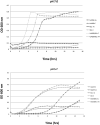A new arginine-based dental adhesive system: formulation, mechanical and anti-caries properties
- PMID: 28587978
- PMCID: PMC5568561
- DOI: 10.1016/j.jdent.2017.05.024
A new arginine-based dental adhesive system: formulation, mechanical and anti-caries properties
Abstract
Secondary caries at the margins of composite restorations has been attributed to adhesive failure and consequent accumulation of cariogenic biofilms.
Objectives: To develop and evaluate an etch-and-rinse adhesive system containing arginine for sustainable release and recharge without affecting its mechanical properties. Arginine metabolism by oral bacteria generates ammonia, which neutralizes glycolytic acids and creates a neutral environmental pH that is less favorable to the growth of caries pathogens, thus reducing the caries risk at the tooth-composite interface.
Methods: Experimental adhesives were formulated with methacrylate monomers and arginine at 5%, 7%, and 10% or no arginine (control). Adhesives were tested for: (i) mechanical properties of true stress (FS and UTS), modulus of elasticity (E), degree of conversion (DC), Knoop hardness number (KHN) and dentin microtensile bond strength (μ-TBS), (ii) arginine release and recharge, and (iii) antibacterial activities. Data was analyzed by t-test, one-way ANOVA and Tukey's tests.
Results: FS and UTS results showed no statistically significant differences between the 7% arginine-adhesive and control, while the results for E, DC, KHN and μ-TBS showed no difference among all groups. The 7% arginine-adhesive showed a high release rate of arginine (75.0μmol/cm2) at 2h, and a more sustainable, controlled release rate (up to 0.2μmol/cm2) at 30days.
Conclusions: Incorporation of 7% arginine did not affect the physical and mechanical properties of the adhesive. Arginine was released from the adhesive at a rate and concentration that exhibited antibacterial effects, regardless of shifts in biofilm conditions such as sugar availability and pH.
Clinical significance: Secondary caries is recognized as the main reason for failure of dental restorations. The development of an arginine-based adhesive system has the potential to dramatically reduce the incidence and severity of secondary caries in adhesive restorations in a very economical fashion.
Keywords: Arginine; Caries; Dental adhesives; Oral biofilms; Secondary caries.
Copyright © 2017 Elsevier Ltd. All rights reserved.
Conflict of interest statement
Figures





Similar articles
-
Bonding of simplified adhesive systems to caries-affected dentin of primary teeth.J Adhes Dent. 2013 Oct;15(5):439-45. doi: 10.3290/j.jad.a28880. J Adhes Dent. 2013. PMID: 23534022 Clinical Trial.
-
Immediate bonding properties of universal adhesives to dentine.J Dent. 2013 May;41(5):404-11. doi: 10.1016/j.jdent.2013.03.001. Epub 2013 Mar 14. J Dent. 2013. PMID: 23499568 Clinical Trial.
-
Correlation between degree of conversion, resin-dentin bond strength and nanoleakage of simplified etch-and-rinse adhesives.Dent Mater. 2013 Sep;29(9):921-8. doi: 10.1016/j.dental.2013.05.001. Epub 2013 Jul 2. Dent Mater. 2013. PMID: 23830512
-
The role of adhesive materials and oral biofilm in the failure of adhesive resin restorations.Am J Dent. 2017 Oct;30(5):285-292. Am J Dent. 2017. PMID: 29178733 Review.
-
Progress in Dental Adhesive Materials.J Dent Res. 2023 Mar;102(3):254-262. doi: 10.1177/00220345221145673. Epub 2023 Jan 24. J Dent Res. 2023. PMID: 36694473 Review.
Cited by
-
Bibliometric Analysis of Literature Published on Antibacterial Dental Adhesive from 1996-2020.Polymers (Basel). 2020 Nov 29;12(12):2848. doi: 10.3390/polym12122848. Polymers (Basel). 2020. PMID: 33260410 Free PMC article. Review.
-
Incorporation of Arginine to Commercial Orthodontic Light-Cured Resin Cements-Physical, Adhesive, and Antibacterial Properties.Materials (Basel). 2021 Aug 5;14(16):4391. doi: 10.3390/ma14164391. Materials (Basel). 2021. PMID: 34442914 Free PMC article.
-
Comparative evaluation of eighth-generation bonding agent modified with 7% arginine and 0.12% chitosan for antibacterial property and microtensile bond strength.J Conserv Dent. 2022 Jul-Aug;25(4):440-443. doi: 10.4103/jcd.jcd_189_22. Epub 2022 Aug 2. J Conserv Dent. 2022. PMID: 36187854 Free PMC article.
-
Smart Dental Materials Intelligently Responding to Oral pH to Combat Caries: A Literature Review.Polymers (Basel). 2023 Jun 8;15(12):2611. doi: 10.3390/polym15122611. Polymers (Basel). 2023. PMID: 37376255 Free PMC article. Review.
-
L-arginine-containing mesoporous silica nanoparticles embedded in dental adhesive (Arg@MSN@DAdh) for targeting cariogenic bacteria.J Nanobiotechnology. 2022 Dec 1;20(1):502. doi: 10.1186/s12951-022-01714-0. J Nanobiotechnology. 2022. PMID: 36457046 Free PMC article.
References
-
- Giachetti L, Bertini F, Bambi C, Scaminaci Russo D. A rational use of dental materials in posterior direct resin restorations in order to control polymerization shrinkage stress. Minerva Stomatol. 2007;56:129–138. - PubMed
-
- Mullejans R, Lang H, Schuler N, Baldawi MO, Raab WH. Increment technique for extended Class V restorations: an experimental study. Oper Dent. 2003;28:352–356. - PubMed
MeSH terms
Substances
Grants and funding
LinkOut - more resources
Full Text Sources
Other Literature Sources
Medical
Research Materials

